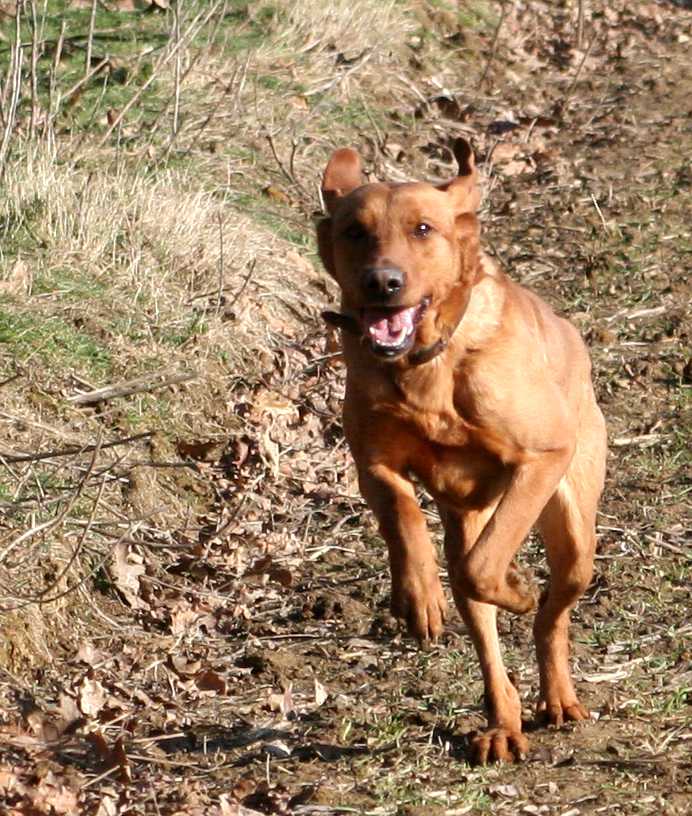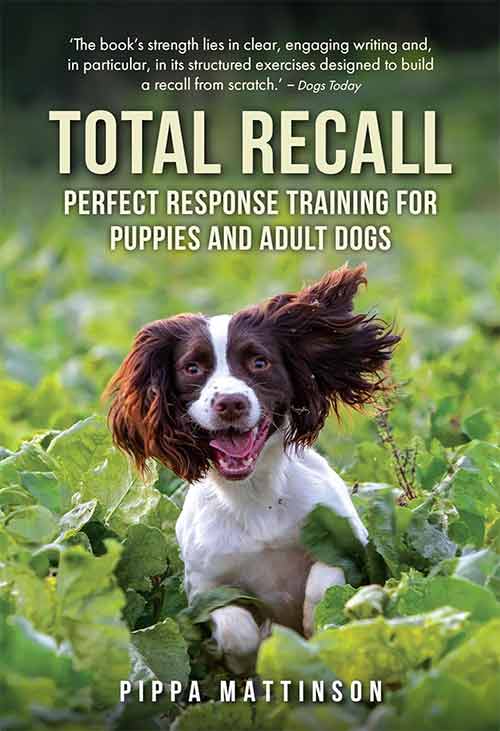Teaching recall to a dog is not a ‘set it and forget it’ affair. It has something in common with building a house, in that you need solid foundations before you add several floors. And if you don’t get the foundations secure you risk the whole thing tumbling down.

But in many ways, recall training is even more like creating a lovely garden. Because it needs to be maintained or it will get overrun with weeds and soon disappear altogether!
What is really great about recall training is that there are many ways to support your dog’s recall, without actually putting it to the test. In fact, almost any modern training exercise or game you play with your dog will help improve a recall.
I specifically say ‘modern training’ because some traditional training techniques can seriously undermine recall. I’ll talk about that in a moment.
Principles that underpin modern recall training
- The dog thinks YOU are amazing to be around
- The dog loves the sound of the recall
- The dog has mastered each level before moving on to the next
In the past dogs were often taught recall by being shown that disobeying the recall command would lead to punishment.
Traditional recall training
For any recall refusal the trainer would literally walk or run the dog down and then pin and punish them. This method was mainstream in gundog training when I started out.
In the USA the ‘running down’ part has been largely replaced with e-collar corrections. In other parts of the world, modern methods have mostly replaced the old school techniques.
Modern recall training system
Before you teach your dog any cue, you need to know exactly what you want your dog to do when they hear that cue.
With recall, what you want is for the dog to get themselves next to you as fast as they can.
With modern methods, the system used to create a trained response for any skill, is the same
- Get the behavior established first
- Pair the behavior with a cue
- Practice getting the response to the cue without distractions
- Add distractions in a structured way
We usually introduce the cue when the behavior has been established. So for example, when we train a dog to SIT, we might mark the dog (with YES or a click) for sitting, then throw a treat and wait from them to sit again. When they are repeatedly sitting to win treats, we give the sit a label “SIT” and use that label repeatedly in situations where we can almost guarantee the dog is about to sit.
This builds a strong association between the cue and the behavior so that when the dog hears the cue, they automatically respond by sitting.
With recall it’s a little different because we introduce the cue from the start. We can do this because the behavior you want is for the dog to get themselves next to you. So pairing that recall cue with being next to you, builds that association between the label and the behavior, perfectly.
Good trainers, traditional or modern, will always add distractions a structured way, starting with simple recalls in locations where the dog is protected from distractions. And progressing to recall in increasing distracting environments as the dog succeeds.
This minimizes mistakes, and in the case of traditional training, punishment. You can read more about introducing distractions here: The 3 Ds Of Dog Training
Mixing methods
Recall training is one of those skills where mixing methods is a really bad idea. That’s because punishment directly opposes one of those three principles or pillars on which modern recall training is supported.
Modern recall training teaches your dog that you are amazing and encourages them to move heaven and earth to be near you. Punishment teaches dogs that you are scary and sometimes painful to be around.
This is why trying to mix these methods usually results in the trainer concluding that modern methods don’t work.
Recall Principle #1 Be amazing!
The best way for your dog to learn that you are amazing is for you to spend time training them and reinforcing their great behaviors.
Pick a skill, any skill, and teach it to your dog. There are no pointless games or skills when it comes to dog training.
You can pick a basic skill such as ‘sit’ or ‘down’, or a more complicated skill such as ‘fetch’. You can teach your dog to wipe their paws, or give you a high five. It simply doesn’t matter. All these things deepen the bond between you and help build your dog’s trust and confidence in you. All of which helps to improve recall.
Recall Principle #2 Help your dog fall in love
If you want your dog to love the sound of your recall, you are going to have to build value for that sound. And make it something the dog strongly associates with pleasure. This is surprisingly easy to do.
All that is required to get started is to feed your dog at your feet and pair that behavior (eating right next to you) with your recall cue.
If your dog is not used to being fed outside of mealtimes, I would start by pairing this feeding event with another sound – a kissing sound for example, or an simple phrase such as ‘tidbit time’ or if you have a puppy you could just say “hey, pup, pup, pup”
Later when your dog is rushing to find you, then you can switch your interim cue for the one you want to keep long term.
What should I feed?
You could just give your dog their dinner (ie their whole day’s food allowance) in a bowl. But I recommend you don’t do this.
That’s because training is a numbers game. The more feeding events that your dog experiences that are paired with the recall cue, the more strongly the cue will be associated with the pleasure of eating right next to you.
So I suggest you divide your dog’s daily rations up into portions and feed them at intervals throughout the day. Check out this article: for more information on training with food
A simple game
The way that you deliver food in recall training is important. If you drop a handful of food in a dish or even on the floor, your dog will eat the lot pretty quickly.
Instead you could place some pieces of food individually on the ground, then while the dog is eating it, move a step or two away and place one or two more treats right next to you.
This means that the dog is actively seeking you out and moving towards you constantly over a period of a minute or so.
However you decide to do this, be generous. Don’t just drop a few crumbs on the floor, put out piece after piece of food. And if your dog is not impressed, dish out some serious value – roast chicken, beef, cheese, that kind of thing.
Pairing the cue
Each time you place some pieces of food on the ground next to you, you’ll give your recall cue as the dog begins to eat.
Don’t use the cue to attract the dog to you, wait until the dog is next to you and eating. The idea is to repeatedly pair the cue with the pleasure of eating at your side.
How often?
Do this as often as you can. Four to six times a day, or more if you can. You can set an alarm on your phone to remind you!
Keep a checklist on your refrigerator and make a note of each time you play this simple game.
Recall Principle #3 Master each level in turn
When your dogs has had plenty of experience (multiple sessions over multiple days) hearing your recall cue while they eat treats next to you, you can start to use the cue. But it’s vital that you only do so, when you can guarantee success.
Use the three letters in CUE to remind you that your dog should be:
- Close
- Undistracted
- Engaged
The dog must be close to you, I’m talking a few feet, no more. There must be NO distractions. Do this indoors, in a small room. No other people, or pets in the room.
And your dog needs to be engaged with you. You should have their attention. So its fine to let them see you topping up your treat bag and for them to know that the fun is about to begin.
None of this is cheating. And none of this is permanent. But for now, you are setting your dog up to win.
Progressing your recall journey
Teaching a recall takes time. This is about getting off to a good start. When you have achieved a recall response under the very limited conditions described above, you need to protect that response, and expand on it. Introducing distractions in careful structured stages.
There are lots of games that can help you with this. You’ll find some of them in our Core Skills training course. A simple example is a game we call ‘You To Me’ where you and a partner stand just a few feet apart and call the dog back and forth between you, while gradually widening the gap between you.
You start by playing games like this well away from other people and dogs, and gradually over time, bring the game closer to distractions.
And once your recall has been thoroughly proofed against distractions, using a variety of games and training exercises, you’ll need to maintain it over time.
I want to stress that it’s never too late to teach your dog a fantastic recall response. If you’d like help with this, and you want to work through a detailed structured training program, you can buy my book Total Recall. It’s suitable for dogs and puppies of all ages.
You can read the reviews using this Amazon linkPaid Link. Please be aware that that is an affiliate link and if you buy the book after clicking on it, Dogsnet receives a small commission which does not affect the price you pay.
If you are more of a visual learner and prefer videos, you can find some helpful recall games in my Core Skills online training course.
You can also get help with recall and any other training issues that you have with your dog by joining our Dogsnet Facebook support group

Free Training Tips
Get Pippa's free dog training tips delivered to your inbox


 Choosing Games: Changing Dog Behavior One Step At A Time
Choosing Games: Changing Dog Behavior One Step At A Time 
My dog(20 months)not an eater-very few treats she likes-going to try recall with cheese—problem with Bella is she bites your shoes as you’re walking-if you remove shoes she will bite sides of your feet-not every time but quite often-is this normal ?
Hi Rose. That doesn’t sound much fun for your feet! If you’d like to pop over to our free support group we can give you some tips on reducing the crocopup behavior 🙂